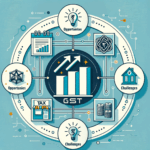How to Manage GST During Economic Downturns: A Guide for Indian Businesses
Navigating an economic slowdown presents a significant challenge for any business owner. Factors like reduced consumer spending, supply chain disruptions, and tight credit markets create a tough operating environment, especially for small and medium-sized enterprises (SMEs) in India. While the natural response is to focus on cutting costs and finding new ways to boost sales, many businesses overlook a critical area that can make or break their financial stability: Goods and Services Tax (GST) management. Proactive and strategic GST handling is not just a compliance task; it is an essential financial lever you must pull to effectively manage economic downturns. This guide is designed specifically for small business owners in India, providing practical, actionable steps to handle your GST obligations, optimize your finances, and navigate the impact of recession on businesses India. This guide builds on the core principles of The Impact of GST on Small and Medium Enterprises by focusing specifically on recessionary periods.
Understanding the Impact of a Recession on GST and Business Finances
To effectively manage GST during a slowdown, you must first understand how economic pressures directly affect your tax obligations and overall cash flow. A recession triggers a chain reaction that can quickly strain your working capital if left unmanaged. The challenges go beyond simply collecting less tax; they create complex issues around payment cycles, compliance costs, and the utility of your tax credits. Mastering financial management during recessions India requires a deep dive into these specific GST-related pressures. The impact of recession on businesses India is felt most acutely in the day-to-day financial operations, where GST plays a surprisingly significant role.
The Direct Effect on Cash Flow and Working Capital
The most immediate effect of an economic downturn is a drop in sales, which naturally leads to lower GST collection from your customers. However, the problem is more complex than just reduced revenue. During tough times, your customers will likely delay their payments to preserve their own cash. This creates a dangerous cash flow gap: you have raised an invoice and are legally liable to pay the GST on it to the government by the due date, but you haven’t actually received the cash from your customer. You are essentially paying tax out of your own pocket on money you haven’t collected. At the same time, your fixed compliance costs, such as your accountant’s fees or software subscriptions, remain constant. This combination of delayed income, immediate tax liability, and fixed overheads puts immense strain on your working capital, making every rupee critical for survival.
The Input Tax Credit (ITC) Trap During a Downturn
Input Tax Credit (ITC) is a cornerstone of the GST regime, allowing you to claim credit for the GST you paid on your business purchases (inputs, raw materials, and services). In a healthy economy, this ITC is quickly utilized against the GST you collect on your sales, reducing your final tax outgo. However, a recession creates an “ITC trap.” When your sales slow down, you are not generating enough output tax liability to utilize the accumulated ITC. This means the GST you’ve already paid on your inputs gets locked up in your GST credit ledger, effectively blocking a portion of your working capital that could have been used for salaries, rent, or other urgent expenses. The risk is further amplified by your suppliers. If a vendor is facing financial distress and fails to file their GSTR-1 and pay their taxes, you will not be able to claim the ITC on their invoices, leading to a direct financial loss and further squeezing your funds.
5 Actionable Strategies to Manage Economic Downturns via Smart GST Management
While the challenges are significant, they are not insurmountable. By adopting a proactive and strategic approach to your GST management, you can mitigate risks, improve cash flow, and build financial resilience. These are not just compliance tips; they are powerful economic downturn strategies for companies that can provide a competitive edge. Implementing these five strategies will help you manage economic downturns and strengthen your business for the long term, fostering business resilience during economic challenges India.
1. Master Your Input Tax Credit (ITC) Reconciliation
Leaving eligible Input Tax Credit unclaimed is like leaving cash on the table—something no business can afford during a downturn. It is absolutely critical to make monthly ITC reconciliation a non-negotiable business process.
- Reconcile Diligently: Every month, without fail, you must reconcile the ITC available as per your GSTR-2B (the auto-populated statement from the GST portal) with your own purchase records. This ensures you are claiming every single rupee of ITC you are entitled to. Any discrepancy should be investigated immediately.
- Follow Up with Suppliers: Your ITC is dependent on your suppliers’ compliance. Implement a robust system to track which suppliers have not filed their GSTR-1, as this directly blocks your credit. Communicate with them regularly and politely, explaining that their timely filing is crucial for your business’s cash flow. In a downturn, you may need to make tough decisions and prioritize vendors with a strong compliance history.
- Automate for Accuracy: Manually tracking dozens or hundreds of invoices is prone to error. Consider using modern accounting software that has built-in GST reconciliation features. Alternatively, professional services, like those offered by TaxRobo’s GST Service, can automate this entire process, saving you time and preventing costly mistakes.
2. Prioritize GST Compliance to Avoid Crippling Penalties
When cash is tight, it can be tempting to delay tax payments or filings. This is a critical mistake that will cost you far more in the long run. Non-compliance is not a cost-saving measure; it is a debt-building activity that can cripple your business.
- Understand the Costs: The penalties for non-compliance are severe. You can learn How to File GST Returns Online: A Step-by-Step Guide of the GST Filing Process & Procedure to avoid these issues. Late filing of GSTR-1 and GSTR-3B attracts a penalty of ₹50 per day (₹20 for nil returns) per return. More importantly, any delay in paying your GST liability incurs interest at a steep rate of 18% per annum. This interest payment is an unnecessary expense that directly eats into your profits.
- Create a Compliance Calendar: Don’t rely on memory. Create a simple calendar with all your GST due dates (GSTR-1, GSTR-3B, annual returns) and set reminders. Assign clear responsibility for these tasks within your team to ensure nothing slips through the cracks.
- Compliance as a Business Asset: Maintaining a clean compliance record is a vital component of
business resilience during economic challenges India. When you need to apply for a business loan or a credit line to navigate the downturn, lenders will scrutinize your GST filing history. A perfect record signals that your business is well-managed and financially disciplined, significantly improving your chances of securing much-needed capital.
3. Optimize Cash Flow with Strategic Planning
Beyond day-to-day compliance, you can use strategic GST planning to actively improve your cash flow. This involves forecasting your liabilities and choosing the right GST scheme for your business model during a recession.
- Forecast and Provision: Don’t let your GST liability be a surprise at the end of the month. Use your sales projections to estimate your likely GST outgo. Set aside these funds in a separate account as you make sales. This simple discipline ensures you have the cash ready when it’s time to pay your taxes, avoiding last-minute scrambling or dipping into your working capital.
- Evaluate the GST Composition Scheme: The Composition Scheme is a powerful tool for
financial management during recessions India. It is designed for small businesses with an annual aggregate turnover of up to ₹1.5 crore (₹75 lakh for some states). Instead of paying normal rates and managing ITC, you pay a low, fixed percentage of your turnover and file a simple quarterly return. For a complete breakdown, refer to our guide Understanding the Composition Scheme Under GST.
| Aspect | Regular GST Scheme | GST Composition Scheme |
|---|---|---|
| Tax Rate | Standard rates (5%, 12%, 18%, 28%) | Low, fixed rate (e.g., 1% for traders) |
| ITC | Can claim ITC on purchases | Cannot claim ITC |
| Tax Collection | Can collect tax from customers | Cannot collect tax from customers |
| Compliance | Monthly/Quarterly returns (GSTR-1, 3B) | Simplified quarterly payments (CMP-08) |
The major trade-off is the inability to claim ITC. However, if your input costs are low and your customers are mainly retail consumers (B2C) who cannot claim ITC anyway, switching to the Composition Scheme can drastically reduce your compliance burden and provide tax certainty. You can check the detailed eligibility criteria on the official GST Portal.
4. Re-evaluate Your Supply Chain and Contracts
An economic downturn is the perfect time to review your business relationships. Your financial health is intrinsically linked to that of your suppliers and customers, and your contracts should reflect the current economic reality.
- Vet Your Vendors: As mentioned earlier, a non-compliant supplier can block your ITC. Go beyond just price and review the GST compliance history of your critical vendors. Prioritize working with businesses that have a reliable filing record. Don’t be afraid to switch suppliers if a key partner consistently fails to meet their obligations, as they represent a direct financial risk to your company.
- Renegotiate Payment Terms: Cash flow is a two-way street. Review your contracts and payment terms with both customers and suppliers. With customers, you could offer a small, early-payment discount to encourage faster settlements. With your suppliers, you can be transparent about the economic situation and try to negotiate a longer credit period. Even an extra 15 or 30 days to pay can make a huge difference in managing your working capital during a crunch.
5. Leverage GST Refunds to Your Advantage
For certain businesses, the GST system can be a source of cash inflow, not just an outflow. If your business is eligible for refunds, pursuing them aggressively is a crucial strategy during a recession.
- Identify Your Eligibility: The most common scenarios for GST refunds are for exporters of goods or services and businesses supplying to Special Economic Zones (SEZs). In these cases, your output is zero-rated, but you continue to pay GST on your inputs. This leads to an accumulation of ITC that can be claimed as a cash refund from the government.
- File Timely and Accurately: Treat the refund application process with the utmost priority. It is a direct cash injection into your business. Ensure your paperwork is accurate and complete to avoid delays or rejections. The government has streamlined the process, but precision is key. This is not just a compliance task; it is an active step in your cash flow management strategy. For official procedures and forms, you can refer to the detailed guidelines on the CBIC website.
Staying Informed on Government Relief Measures
During significant economic downturns, the Indian government often introduces relief measures to support businesses. These can include extensions of GST return filing due dates, waivers of late fees, or reductions in interest rates for delayed payments. Staying on top of these announcements can provide you with crucial breathing room.
How to Monitor for GST-Related Announcements
Relying on unverified news or social media updates can be misleading. It is essential to get your information from official sources to make accurate business decisions.
- Official Portals: Regularly check the official websites for the latest notifications and circulars. The primary sources are the GST Portal and the Central Board of Indirect Taxes and Customs (CBIC). Bookmark these sites and check them at least once a week.
- Partner with Experts: The world of tax compliance is constantly evolving, especially during turbulent times. This is where
managing economic downturns Indiabecomes easier with professional help. Partnering with a dedicated tax consultant like TaxRobo ensures you are always informed about relevant changes. We monitor all official announcements and provide our clients with timely, easy-to-understand updates and advice on how to leverage any available relief measures.
Conclusion
In challenging economic times, every decision matters. While it’s easy to get consumed by sales and cost-cutting, overlooking GST management can lead to severe cash flow issues and unnecessary penalties. The key takeaways are clear: mastering your Input Tax Credit, prioritizing 100% compliance, planning your cash flow strategically, and actively vetting your supply chain are the essential pillars to manage economic downturns. Think of your GST strategy not as a mere legal obligation, but as a powerful financial tool at your disposal. Proactive management builds the business resilience during economic challenges India that not only ensures survival but also positions your business for strong growth when the economy recovers.
Navigating GST during a recession can be complex and overwhelming. You don’t have to do it alone. The experts at TaxRobo are here to help you develop robust economic downturn strategies for companies and ensure your finances are optimized for resilience. Contact us today for a personalized consultation and let us help you turn your tax compliance into a strategic advantage.
Frequently Asked Questions (FAQs)
1. Can I just stop filing GST returns temporarily if I have no sales?
No, you must file a Nil return for the tax period. The law requires you to file a GSTR-1 and GSTR-3B for every registration period, even if you have zero sales or purchases. Failure to file, even a Nil return, will result in the standard late fees and can break your compliance record. It’s a simple process that saves you from an unnecessary financial burden you want to avoid during a downturn.
2. Is switching to the Composition Scheme a good idea during a recession?
It can be a very effective strategy for financial management during recessions India if your business model is a good fit. If you don’t rely heavily on ITC from your purchases (e.g., you are in a service industry with low input costs) and your customers are primarily retail (B2C), the simplified compliance and lower tax rate can significantly improve cash flow and reduce administrative overhead. However, if you are a B2B business, your customers will not be able to claim ITC on your supplies, which might make you less competitive. Always analyze the impact of losing ITC before making the switch.
3. What is the fastest way to improve my cash flow related to GST?
The two fastest and most impactful ways are:
- Diligently reconcile and claim 100% of your eligible Input Tax Credit every single month. This prevents your money from getting stuck in the system.
- If you are an exporter or supply to SEZs, file for your GST refunds immediately. A refund is a direct cash injection back into your business. The faster and more accurately you file, the faster you get your money.
4. My customer has not paid me, but do I still have to pay GST on the invoice?
Yes, unfortunately, you do. Under the GST law, your tax liability arises at the “time of supply,” which is generally the date you issue the invoice, not the date you receive payment. This is why managing your debtors and having strict credit control policies is extremely important. Proactively following up on payments is a critical business function, especially during a recession when cash flow is king.



